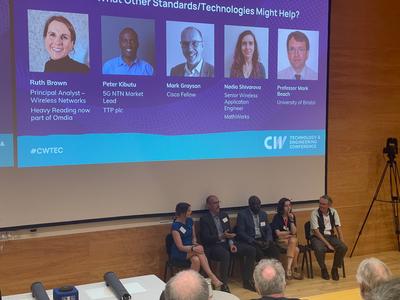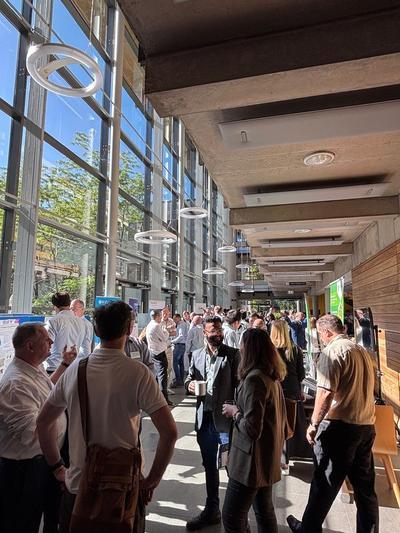CWTEC: 6G Anarchy in the UK – how does the UK get what it needs in the 6G era?
Acknowledging that 6G is still in its conceptual and requirements-setting stage, the conference deliberately questioned the fundamentals - “Is 6G needed?” and “What should it deliver for the UK?”
Speakers offered a diversity of views, but clear common themes emerged by day’s end.
Setting the National Vision
Catherine Page from DSIT opened the day by laying out the UK government’s strategic vision for advanced connectivity, based on the recently published UK Infrastructure: A 10 Year Strategy. Notably, the emphasis was on advanced connectivity instead of 6G directly, recognising that multiple solutions (beyond mobile) are needed and that current networks still require substantial improvement.

She outlined four strategic pillars:
- Ubiquitous connectivity – recognising high quality mobile connectivity as essential for both businesses and individuals with action needed to improve current services as well future connectivity requirements particularly around a digital first infrastructure vision in other areas such as energy and transport
- Security and trust – towards supporting achievement of net zero goals with a need to innovate to improve energy efficiency in mobile infrastructure and devices
- Sustainability – towards supporting achievement of net zero goals with a need to innovate to improve energy efficiency in mobile infrastructure and devices
- UK tech leadership – Through skills, investment, and innovation, the UK must remain a competitive base for developing and adopting advanced technologies.
There was also recognition that the future of connectivity isn’t purely technical - it must be commercially viable, requiring strong public-private collaboration to innovate on deployment models.
Reframing 6G: A Grounded Approach
Dr. Mike Short (UK Telecoms Lab) introduced his "6Cs" framework for 6G:
- Cost – Services must be affordable and scalable
- Coverage – A vital requirement for 6G with coverage gaps still an issue
- Capability – Long term capabilities to networks for future services
- Content – Continuing to deliver the rich set of services available today and having the network capability in place to add to these as new ones emerge
- Choice – More options for networks and services
- Cybersecurity – security and resilience of connectivity infrastructure remains a key issue.
Unlike speculative 6G conversations full of sci-fi-like scenarios, CWTEC kept things practical. Many talks linked enabling technologies back to real-world network challenges, reinforcing a more grounded and actionable 6G roadmap.
Technologies in Focus
There was strong representation from the Non-Terrestrial Network (NTN) community, highlighting the importance of interoperability between terrestrial and non-terrestrial networks to support true ubiquity. Speakers referenced encouraging signs such as:
- 3GPP’s recognition of the need to harmonise TN and NTN radio design.
- Hybrid device developments from companies like EnSilica.
Indoor connectivity was also a hot topic. Mark Grayson revisited the long-running Wi-Fi and cellular interworking debate (now on attempt 14 in 3GPP!) and argued that indoor ubiquity cannot be left behind. Meanwhile, Andy Jones spotlighted cell-free distributed massive MIMO as a potential route to achieving the ultra-high reliability needed for Industry 5.0 applications.
Sustainability efforts were also showcased, with Mark Beach discussing energy-efficient RF design - particularly power amplifiers - as an urgent area of innovation.
Standards, Simplification, and Real-World Evaluation
A dedicated standards session raised some philosophical questions: Does 6G need to be more complex than 5G? Moray Rumney proposed the opposite, suggesting that simplification and focused performance improvements (e.g. antenna form factor) might serve the industry better than yet another layer of technical optionality.
Other speakers emphasised the need for realistic evaluations of new technologies -beyond lab conditions - to understand their true impact across end-to-end networks.
Making 6G Deliverable
Julie Bradford, Head of Techno-Economic Analysis at Real Wireless, closed the conference by addressing what it will take for 6G to succeed in the UK:
- Network and service commercial viability.
- Alignment with sustainability objectives.
- Thoughtful policy and funding frameworks.
- Shared and evolving best practices for deployment.
Closing Thoughts

CWTEC was unified in its pragmatic outlook. The day reflected broad agreement on a vision of simpler, more secure, more sustainable, and more accessible infrastructure. Yet equally, there was consensus that significant improvements can, and should, be made to current connectivity infrastructure ahead of 6G’s eventual arrival.
Paul Morris, VP RF and Communications at EnSilica summed up the event:
“CWTEC delivered on moving the 6G debate forward and it was great be able to speak about the NTN and PNT aspects. Key themes coming out of the day were more coverage from NTN, better power efficiency through simplification, AI integration and advanced semiconductors, smarter antennas, and quantum-safe security along with a continued loose coupling with Wi-Fi, leveraging HTTP3. No hype in sight at this event. Well done CW.”
CWTEC was proudly supported by MathWorks and EnSilica, with Ranplan Wireless, VIAVI Solutions and Mathys & Squire exhibiting throughout the day.
With thanks to Julie Bradford for the post event review.
Thank you for the pictures taken by ctm Information Technology and Eldhose Johny
